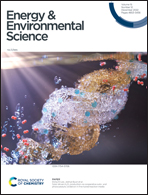Ampere-level CO2 reduction to multicarbon products over a copper gas penetration electrode†
Abstract
Renewable energy-driven electrochemical CO2 conversion to value-added chemicals is a prospective strategy for addressing both carbon emission and energy consumption. Although considerable progress has been made in CO2 electroreduction, sustained production of multicarbon compounds at a high current density remains a challenge. Herein, we report a hierarchical micro/nanostructured Cu(100)-rich copper hollow fiber as a gas penetration electrode (GPE) that reduces CO2 to C2+ products with a faradaic efficiency of 62.8% and a current density of 2.3 A cm−2 in 0.5 M KHCO3 solution at −1.94 V (vs. RHE), outperforming state-of-the-art Cu-based catalysts. Electrochemical results demonstrate that optimized mass transfer and an enhanced three-phase interface reaction synergistically promote CO2 activation and reduction kinetics. Theoretical calculations further suggest that the Cu(100) facet of the Cu GPE favors CO* intermediate adsorption and then facilitates C–C coupling, resulting in selective C2+ product formation. This work provides an attractive avenue to achieve industrial current densities to produce multicarbon products via rational electrode designs.



 Please wait while we load your content...
Please wait while we load your content...